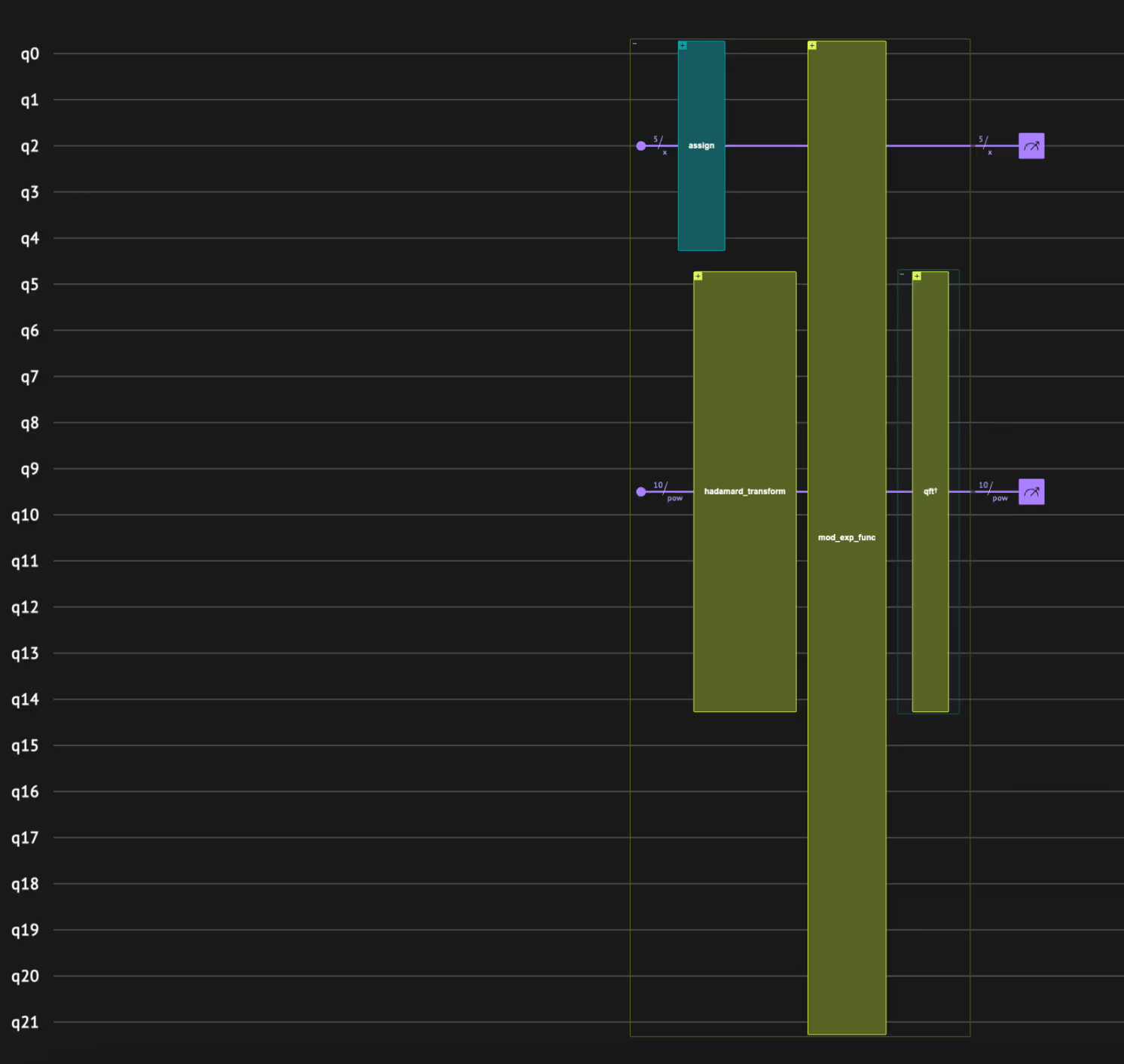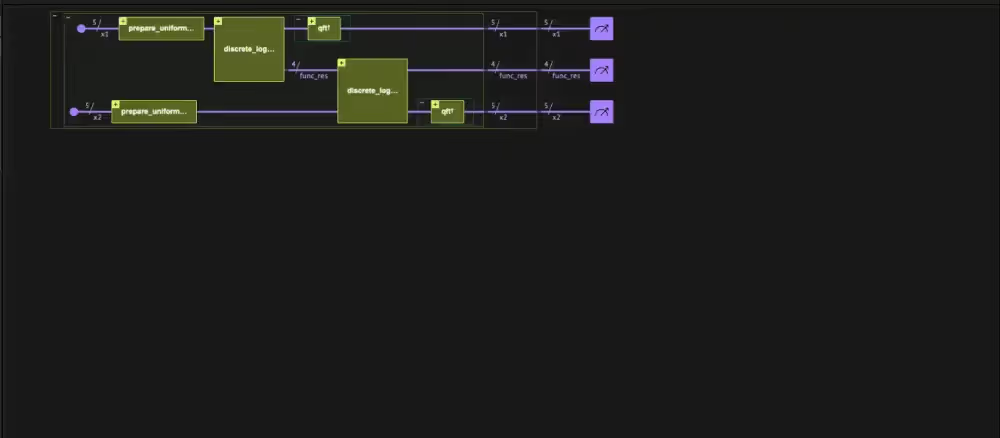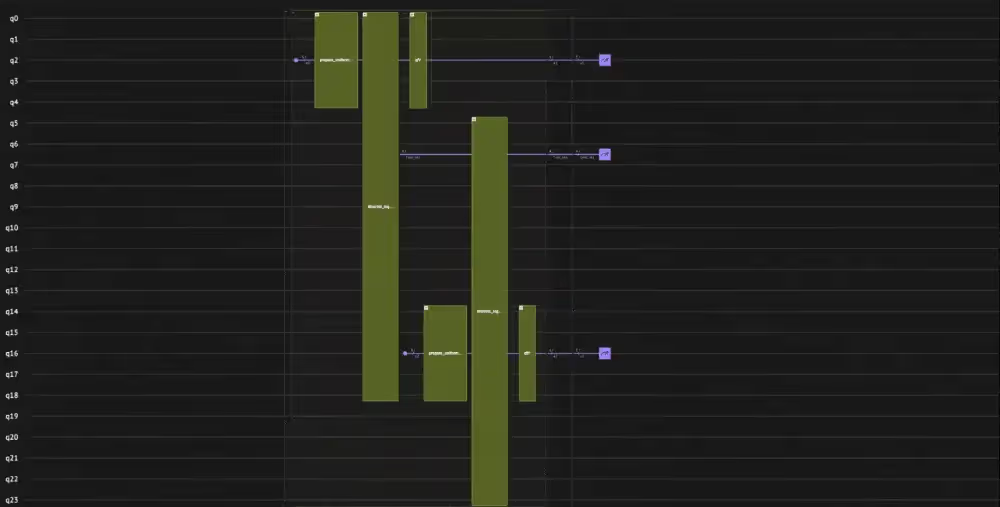Simplifying Quantum Program Analysis: Introducing Variables View
As quantum circuits grow in complexity, traditional qubit-by-qubit visualization becomes insufficient for developers tackling sophisticated algorithms. While such low-level views may suffice for small-scale examples, they quickly become unwieldy across grids of hundreds or thousands of qubits. More critically, they fail to communicate the high-level structure and intent of the algorithm.
To address this, Classiq introduced the Qmod language, enabling algorithm designers to work with high-level quantum constructs—such as numerics, structs, and arrays—encapsulated within functional blocks. These abstractions empower users to think in terms of intent, but they also demand better tools to visualize and debug programs at the same level of abstraction.
Introducing "Variables View" - a new compact visualization mode that displays quantum data flow at a higher level perspective. Toggle between this streamlined view and the traditional qubit grid overlay using the Variables View switch in the visualization menu bar.
Why Variables View Matters
Traditional quantum debugging tools focus on individual qubits, but at a higher level quantum programs are expressed in terms of quantum variables - logical groupings of qubits that represent meaningful application-level data items. Variables View bridges this gap visually by:
- Abstracting complexity: Instead of tracking dozens of individual qubits, see the flow of variables
- Following data flow: Trace how quantum variables are defined, allocated, and transformed through function calls
- Scaling with program size: Maintain visual clarity even in complex algorithms with hundreds of qubits
Best of Both Worlds
Variables View doesn't replace the detailed qubit grid - it complements it. Developers can seamlessly toggle between the high-level variable perspective and the traditional qubit-by-qubit view. When debugging, start with Variables View to understand the overall program structure, then drill down to the qubit level for detailed analysis.
The example above shows Variables View applied to Shor's algorithm, where complex quantum operations are presented as high-level functional blocks applied to numeric variables, rather than overwhelming qubit grids.
Variables View represents a significant step forward in making quantum program analysis more intuitive and scalable for complex algorithms.
Quantum program visualization of a simple Shor algorithm toy model - implemented over only 22 qubits:
Variables view:

Variables view overlayed on the qubit grid:

Open this circuit in our platform: Classiq Platform
Quantum program visualization of a simple Discrete Log algorithm toy model - implemented over only 15 qubits:
Variables view:

Open this circuit in our platform: Classiq Program
Quantum program visualization of a simple Discrete Log algorithm toy model - implemented over only 24 qubits:
Variables View:

Open this circuit in our platform: Classiq Platform
Variables view overlayed on the qubit grid:


As quantum circuits grow in complexity, traditional qubit-by-qubit visualization becomes insufficient for developers tackling sophisticated algorithms. While such low-level views may suffice for small-scale examples, they quickly become unwieldy across grids of hundreds or thousands of qubits. More critically, they fail to communicate the high-level structure and intent of the algorithm.
To address this, Classiq introduced the Qmod language, enabling algorithm designers to work with high-level quantum constructs—such as numerics, structs, and arrays—encapsulated within functional blocks. These abstractions empower users to think in terms of intent, but they also demand better tools to visualize and debug programs at the same level of abstraction.
Introducing "Variables View" - a new compact visualization mode that displays quantum data flow at a higher level perspective. Toggle between this streamlined view and the traditional qubit grid overlay using the Variables View switch in the visualization menu bar.
Why Variables View Matters
Traditional quantum debugging tools focus on individual qubits, but at a higher level quantum programs are expressed in terms of quantum variables - logical groupings of qubits that represent meaningful application-level data items. Variables View bridges this gap visually by:
- Abstracting complexity: Instead of tracking dozens of individual qubits, see the flow of variables
- Following data flow: Trace how quantum variables are defined, allocated, and transformed through function calls
- Scaling with program size: Maintain visual clarity even in complex algorithms with hundreds of qubits
Best of Both Worlds
Variables View doesn't replace the detailed qubit grid - it complements it. Developers can seamlessly toggle between the high-level variable perspective and the traditional qubit-by-qubit view. When debugging, start with Variables View to understand the overall program structure, then drill down to the qubit level for detailed analysis.
The example above shows Variables View applied to Shor's algorithm, where complex quantum operations are presented as high-level functional blocks applied to numeric variables, rather than overwhelming qubit grids.
Variables View represents a significant step forward in making quantum program analysis more intuitive and scalable for complex algorithms.
Quantum program visualization of a simple Shor algorithm toy model - implemented over only 22 qubits:
Variables view:

Variables view overlayed on the qubit grid:

Open this circuit in our platform: Classiq Platform
Quantum program visualization of a simple Discrete Log algorithm toy model - implemented over only 15 qubits:
Variables view:

Open this circuit in our platform: Classiq Program
Quantum program visualization of a simple Discrete Log algorithm toy model - implemented over only 24 qubits:
Variables View:

Open this circuit in our platform: Classiq Platform
Variables view overlayed on the qubit grid:




.svg)










